So, you need to jack up a car but the only place you have to work is on a hill. You’re probably wondering if that’s even possible to do safely. The good news is yes, you can jack up a car on a hill, you just have to take some extra precautions.
The most important thing is making sure the jack stands are placed properly on level ground. You’ll also want to chock the wheels, set the emergency brake, and consider using extra jack stands for stability.
With the right equipment and technique, you’ll become a “shade tree mechanic” and have your car lifted in no time. Just be sure to put safety first on the sloped driveway surface.
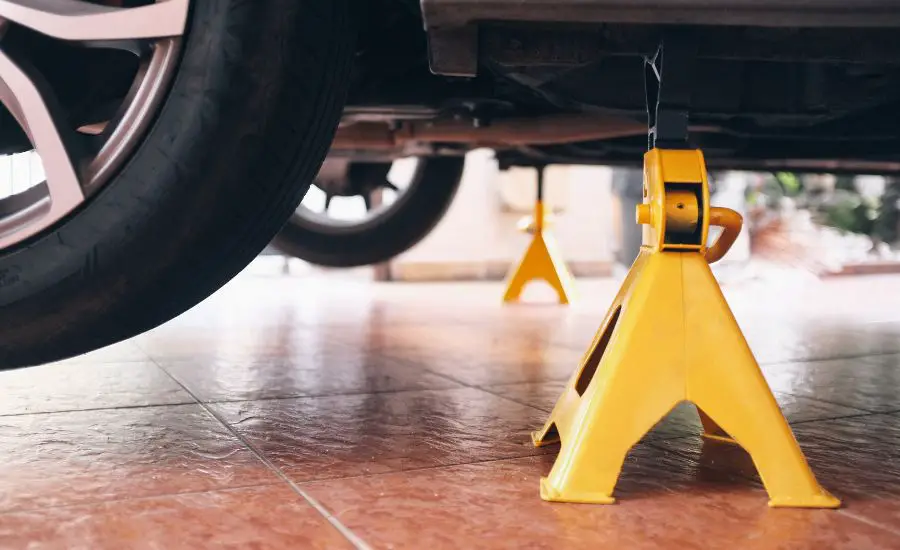
Table of Contents
Safety precautions to take
Safety should always come first when jacking up a vehicle, especially when a car is on an incline.
Here are some precautions to take:
Find a level spot. If possible, park the car on a flat, even surface. If jacking up the car on an incline or a hill is unavoidable, position the jack stands on the wheels opposite the downhill side of the vehicle for maximum stability.
Use car jacks. Place the car jack under the vehicle’s frame near the designated jacking points.
Never rely only on the jack to support the vehicle’s weight, remember to use jack stands for additional support.
Start on the downhill side. When positioning most car jacks and jack stands, start with the downhill side of the vehicle first before moving sideways. This helps ensure it remains balanced as you work.
Double-check everything. Once the vehicle is raised, give all equipment a final inspection to ensure the car jack is secured, chocks are in place, and tires are completely off the ground before crawling under the car.
Stay out from under the vehicle as much as possible. Only go under the vehicle when necessary to place or remove car jacks. Never get under a vehicle supported only by a jack.
Following these essential jack points and safety tips will help ensure you can jack up a car on a hill securely and without incident.
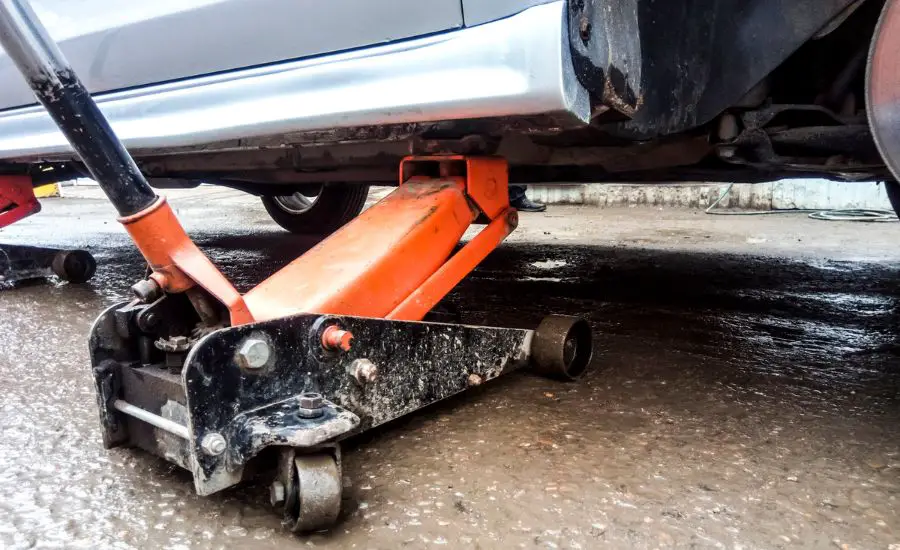
What you will need
To jack up a car safely on a hill, you’ll need some important equipment and to take proper precautions.
- Wheel chocks: these wedge-shaped blocks prevent the wheels from rolling. Place them in front of and behind the tires on the downhill side of the car.
- Jack stand: car jack supports the vehicle after jacking up a car. For a hill, you’ll want extra-tall stands that can handle the weight of your specific vehicle.
- A hydraulic jack: a jack lifts the vehicle, so you can position the car jack stands. For a hillside, use a jack with a wide, sturdy base. Place the car jack under the vehicle’s frame according to the owner’s manual.
- Wheel ramps (optional): wheel ramps provide an extra layer of safety in case the stand becomes unstable or moves. Drive the vehicle up the car ramps before jacking up a car.
- Emergency brake (e-brake): engage the e-brake to prevent the vehicle from rolling in case the wheel chocks fail.
- Spotter (optional, but recommended): have someone guide you as you jack up a car and place the stands. An extra set of eyes is helpful, especially when the car is on a slope.
Double-check that the stands are secure before lowering the jack. For maximum safety, you can’t be too careful when jacking up a car on a slope. Take your time and put safety first.
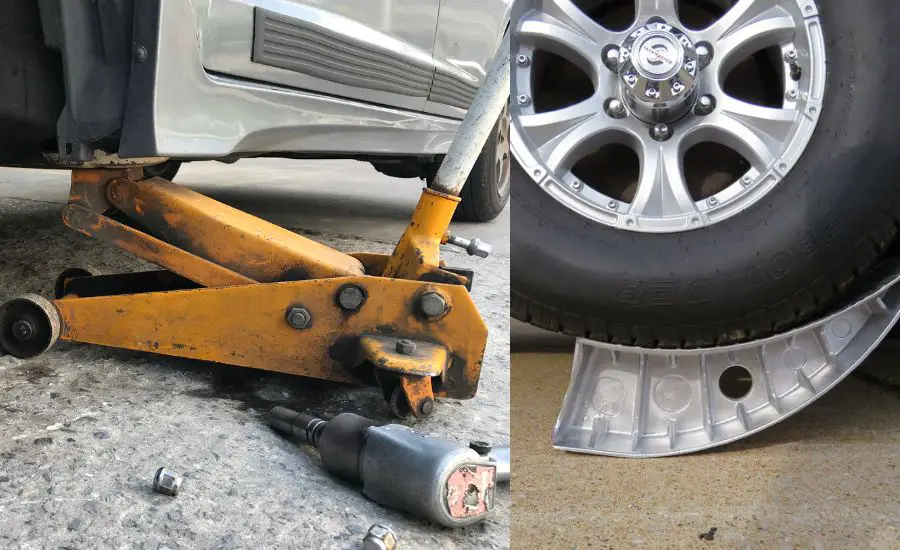
Parking and securing the vehicle
Once you’ve gathered the necessary equipment and prepared the area around your vehicle, it’s time to get the car in position. Parking on an inclined surface with an incline requires extra precautions to ensure safety for you, other vehicles, and your vehicle.
- Find a level spot
If possible, park the car on the most stable surface-level area of the hill. This will minimize the risk of the jack slipping or the vehicle rolling once lifted. You may need to turn the front wheels to secure the vehicle in place after jacking up a car.
- Engage the brake
Firmly engage the parking brake to lock the rear wheels in place. This is critical for stability on an even slight incline, too.
- Place wheel chocks
For added safety, place chock wheels or large wooden blocks on the floor jack on each side of the front wheels to prevent any rolling. Wheel chocks, which can be purchased at most auto parts stores, are specifically designed to securely wedge against tires.
- Consider a spotter
If jacking up a car on a slope, it’s a good idea to have someone act as a spotter. They can help guide you into the proper position, ensure the vehicle remains stable as it’s lifted, and watch for any signs that it may become unstable or start to roll.
- Jack at recommended points
Consult your owner’s manual to locate the recommended jack points on your vehicle’s frame.
These points are specifically reinforced to support the weight of the vehicle during jacking.
Placing the jack at any other point could damage the frame or cause instability. Because of this, there’s no chance of the car sliding or falling off the jack, which could lead to severe injuries.
- Raise and secure
Once the jack is positioned properly under the jacking point, begin raising the vehicle slowly and steadily while checking frequently that it remains balanced and secure. Once the car slowly lifted, immediately slide the jack stands into place and lower the vehicle onto them before making any repairs.
Following these steps carefully will allow you to jack up a car on a slope. But if at any point you feel unsafe or unable to properly secure the vehicle, it’s best to call for roadside assistance or a tow truck instead. Your safety is the top priority.
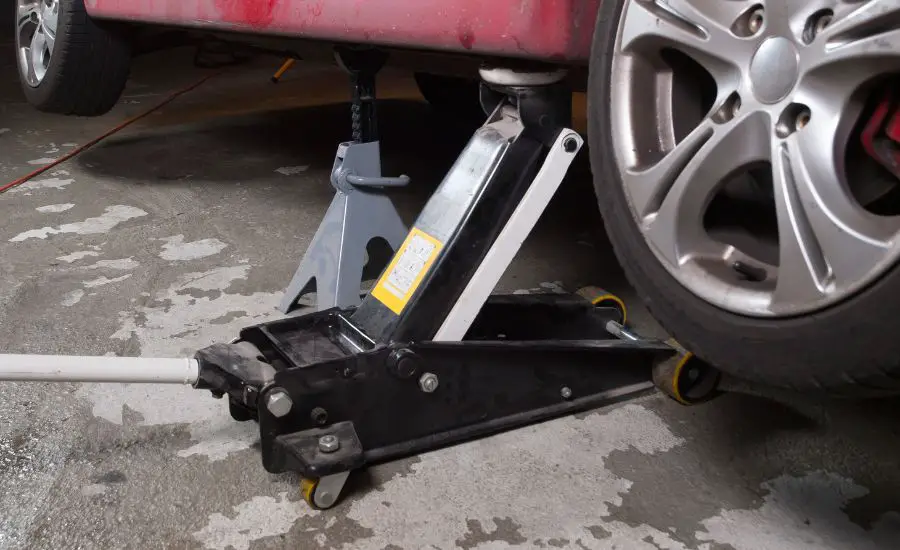
Positioning the jack stands
Once you have the jack in place under your vehicle’s frame, you’ll need to position the jack stands to support the weight of the car before removing the jack.
Place the jack stands under the frame:
- Locate the vehicle’s frame rails – these are the main structural beams that run the length of the underside. The frame rails are the strongest, safest points to support the weight of the vehicle.
- Adjust the jack stands to the proper height before sliding them under the car. You want them just high enough so that when the car is lowered onto the stands, the tires are still slightly off the ground.
- Slowly lower the vehicle onto the jack stands using the jack. Double-check that the jack stands are solidly in place and supporting the weight of the vehicle before removing the jack.
Safety tips:
- Never overload the jack stands. Only raise the vehicle as high as needed to do your work.
- Ensure the jack stand is rated for the weight capacity of your specific vehicle make and model.
- Place the jack stands on a hard, level surface. Soft or uneven ground can cause instability.
- Shake the vehicle to ensure it’s balanced before sliding underneath. The car should not rock or tilt.
- Never leave a raised vehicle unsupported. Always use a rated jack stand.
By following these steps and safety tips, you’ll be able to jack up your car on a slope and have full access to your work underneath the underside.
But remember, always put safety first when working under a raised car.
Lifting one side of the vehicle at a time
Lifting one side of the vehicle at a time requires some extra precautions to keep things balanced and avoid accidents.
- Start with the front or rear wheels
It’s easier and safer to lift either the front or rear of the vehicle first before moving to the other end. If lifting the car ramps to the front, place the wheels chock behind the rear tires to prevent rolling. Do the same for the front tires if starting with the rear.
- Check your work
Once one end is lifted and supported, double-check that the floor jack stands are secure and stable before moving to the other end. Shake the vehicle slightly to ensure it’s balanced before crawling underneath.
- Be extremely cautious
When working under a vehicle supported on one end, exercise extreme caution. The center of gravity is shifted, and the vehicle could become unstable if you jerk or bump the raised end.
- Lower carefully
Slowly and carefully remove the jack stands, one at a time, while checking that the vehicle remains balanced after each removal.
Have another person guide you to ensure the end is coming down evenly. Replace the wheel chocks to prevent rolling before moving to lower the other end.
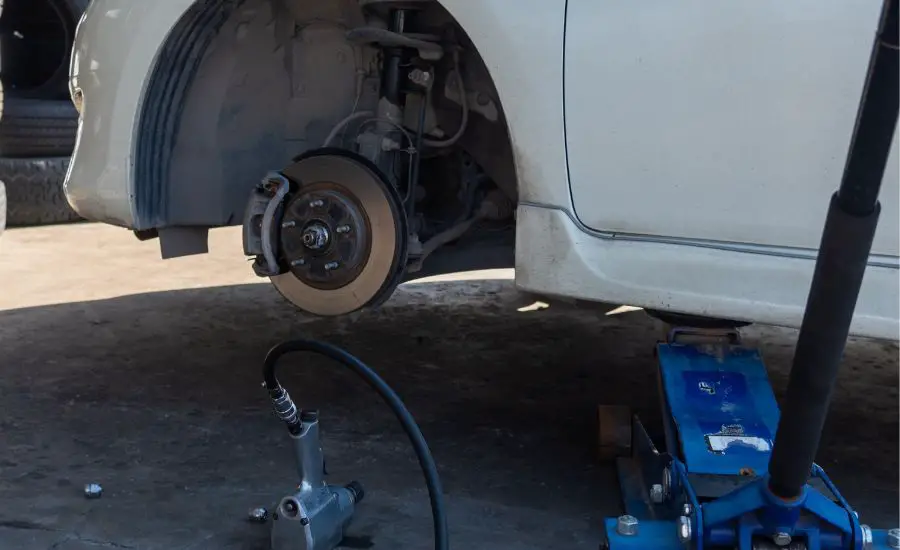
Ensuring the vehicle is balanced
Once you have the jack in place and are ready to start lifting, ensuring the vehicle is balanced is critical for safety.
- Distribute the weight evenly
This means:
- Remove heavy equipment, tools, or cargo from the vehicle. The lighter the load, the easier it will be to jack up and the less likely it is to become unbalanced.
- Position the jack at the recommended jacking point for your specific vehicle make and model. These points are designated by the vehicle manufacturer to properly support the weight.
- For most vehicles, the lifting spots will be next to the flat tire you want to remove. Place the jack directly under the jacking point to distribute the weight properly.
- If jacking up the front or rear axle, place the jack at the axle stands or frame to balance the entire axle. Jacking up one side of an axle could cause the vehicle to tilt or sway. You must never rely solely on the car jack since there is always a chance of the car falling.
- Secure the vehicle
- Place the jack stand under the axle stands to support the weight. Do not rely on the jack alone to hold up the vehicle. Typically, cars have 4 jacking points, which are located under the car’s rocker panels.
- Lower the vehicle onto the jack stand. Ensure the vehicle is balanced before working under it or removing a flat tire.
If at any point the vehicle feels unstable, lower it back to the ground immediately.
It’s not worth the risk of injury to yourself or damage to the vehicle. Be careful not to let the car fall off the jack!
Performing repairs under a raised vehicle
Once you have the car jacked up, you’ll need to work safely under the vehicle to perform any necessary repairs or maintenance.
By securing the vehicle, protecting yourself, having the right tools, and working efficiently, you can safely do maintenance and repairs with the car jacked up.
Jacking up a car on a slope does require extra caution, but by taking your time, using quality equipment, and following all the proper steps, you can do so safely.
If at any point you do not feel fully comfortable, avoid jacking yourself, call for roadside assistance or a tow truck instead. Safety first!

FAQ
Avoid jacking a truck on unstable ground. Instead, keep yourself away from potentially hazardous terrain. Install concrete driveway floors or garages.
You must use a ratchet jack when lifting a heavy car on an incline. Scissors and wide base bottle jacks could also be used for this purpose, as they don’t have wheels.
Maximal lifting is essential to determine car lifting height. Most vehicles have jacks of 20 inches.
Yes, the car should be in gear (manual transmission) or park (automatic transmission) when jacking to ensure stability and prevent it from rolling.
Place the jack and jack stands under the vehicle’s frame, not the axle stand or suspension. For most cars, the frame rail is the strongest and safest jacking point.
Refer to your owner’s manual for the designated jacking and axle stand locations. Position the jack stands as close to the jacking points as possible.
To lower the vehicle:
1. Clear the area around the vehicle.
2. Use wheel chocks to secure wheels.
3. Release hydraulic jack pressure slowly, lowering onto jack stands.
4. Remove the jack, then reposition it to lift the car off the stands.
5. Remove the stands and slowly lower the vehicle to the ground with the jack.
6. Remove the jack and clear away wheel chocks and safety equipment.
Conclusion
So, there you have it, the basics for jacking up your car on an incline. While it may seem tricky, if you take the necessary safety precautions and have the right equipment, you’ll be changing that flat in no time.
Just remember to engage the parking brake, block the wheels, and place the jack stands on a solid, level area of the frame. Now get out there and change that spare tire – you’ve got this.



1 thought on “Can you jack up a car on a hill: what you need to know”